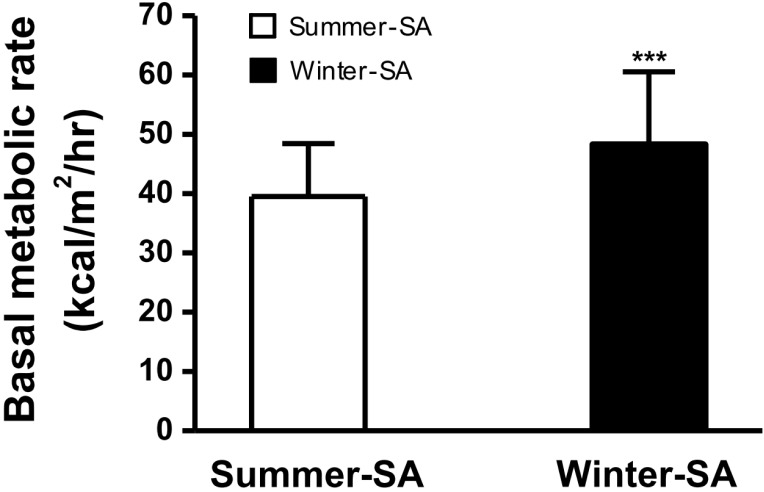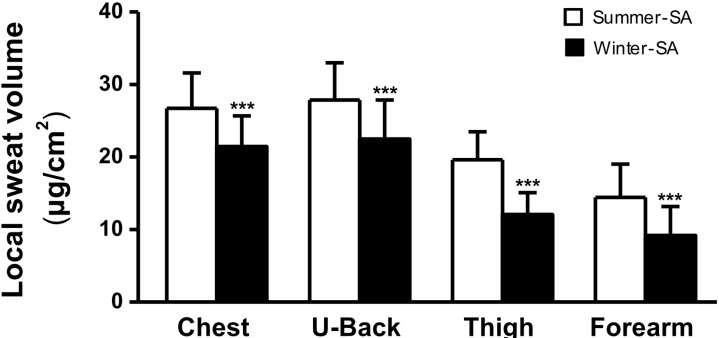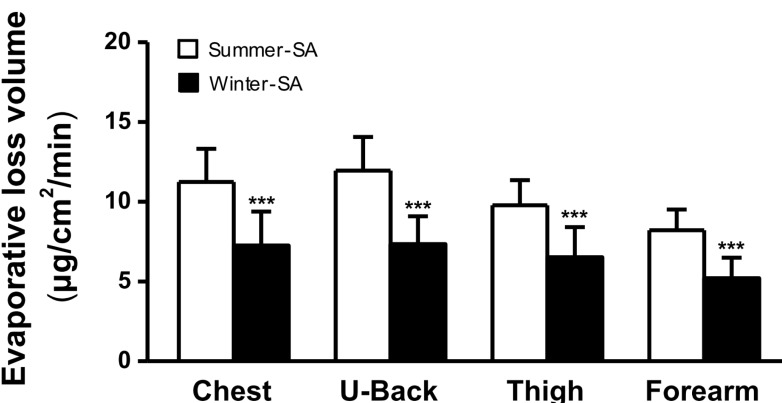1. Fox RH, Löfstedt BE, Woodward PM, Eriksson E, Werkstrom B. Comparison of thermoregulatory function in men and women. J Appl Physiol. 1969; 26:444–453. PMID:
5775330.

2. Henane R, Valatx JL. Thermoregulatory changes induced during heat acclimatization by controlled hypothermia in man. J Physiol. 1973; 230:255–271. PMID:
4708895.
3. IUPS Thermal Commission. Glossary of terms for thermal physiology. Jpn J Physiol. 2001; 51:245–280.
4. Irion GL. Responses of distance runners and sprinters to exercise in a hot environment. Aviat Space Environ Med. 1987; 58:948–953. PMID:
3675466.
5. Taniguchi Y, Sugenoya J, Nishimura N, Iwase S, Matsumoto T, Shimizu Y, Inukai Y, Sato M. Contribution of central versus sweat gland mechanisms to the seasonal change of sweating function in young sedentary males and females. Int J Biometeorol. 2011; 55:203–212. PMID:
20532572.

6. Lee JB, Kim TW, Min YK, Yang HM. Seasonal acclimatization to the hot summer over 60 days in the Republic of Korea suppresses sweating sensitivity during passive heating. J Therm Biol. 2013; 38:294–299.

7. Lee JB, Kim TW, Shin YO, Min YK, Yang HM. Effect of the Heat-exposure on Peripheral Sudomotor Activity Including the Density of Active Sweat Glands and Single Sweat Gland Output. Korean J Physiol Pharmacol. 2010; 14:273–278. PMID:
21165324.

8. Shin YO, Lee JB, Min YK, Yang HM. Heat acclimation affects circulating levels of prostaglandin E2, COX-2 and orexin in humans. Neurosci Lett. 2013; 542:17–20. PMID:
23523649.

9. DuBois D, DuBois EF. Clinical calorimetry 10: a formula to estimate the approximate surface area if height and weight be known. Arch Intern Med. 1916; 17:303–311.
10. Maughan RJ, Shirreffs SM, Ozgünen KT, Kurdak SS, Ersöz G, Binnet MS, Dvorak J. Living, training and playing in the heat: challenges to the football player and strategies for coping with environmental extremes. Scand J Med Sci Sports. 2010; 20(Suppl 3):117–124. PMID:
21029198.

11. Kim TW, Shin YO, Lee JB, Min YK, Yang HM. Caffeine increases sweating sensitivity via changes in sudomotor activity during physical loading. J Med Food. 2011; 14:1448–1455. PMID:
21883004.

12. Lee JB, Bae JS, Matsumoto T, Yang HM, Min YK. Tropical Malaysians and temperate Koreans exhibit significant differences in sweating sensitivity in response to iontophoretically administered acetylcholine. Int J Biometeorol. 2009; 53:149–157. PMID:
19048305.

13. Lee JB, Bae JS, Shin YO, Kang JC, Matsumoto T, Toktasynovna AA, Kaimovich AG, Kim WJ, Min YK, Yang HM. Long-term tropical residency diminishes central sudomotor sensitivities in male subjects. Korean J Physiol Pharmacol. 2007; 11:233–237.
14. Ramanathan NL. A new weighting system for mean surface temperature of the human body. J Appl Physiol. 1964; 19:531–533. PMID:
14173555.

15. Sugenoya J, Ogawa T. Characteristics of central sudomotor mechanism estimated by frequency of sweat expulsions. Jpn J Physiol. 1985; 35:783–794. PMID:
4079134.

16. Pinnagoda J, Tupker RA, Agner T, Serup J. Guidelines for transepidermal water loss (TEWL) measurement. A report from the Standardization Group of the European Society of Contact Dermatitis. Contact Dermatitis. 1990; 22:164–178. PMID:
2335090.
17. Shimaoka A, Machida K, Kumae T, Sugawara K, Kurakake S, Okamura N, Suemune J. Seasonal variation of basal metabolism. Jpn J Biometeorol. 1987; 24:3–8.
18. Scholander PF, Hammel HT, Andersen KL, Loyning Y. Metabolic acclimation to cold in man. J Appl Physiol. 1958; 12:1–8. PMID:
13502248.

19. Hori S. Adaptation to heat. Jpn J Physiol. 1995; 45:921–946. PMID:
8676578.

20. Hensel H. Thermoreception and temperature regulation. London: Academic;1981. p. 219–234.
21. Nakamura Y, Okamura K. Seasonal variation of sweating responses under identical heat stress. Appl Human Sci. 1998; 17:167–172.

22. Blatteis CM. Prostaglandin E2: a putative fever mediator. In : Mackowiak PA, editor. Fever: Basic Mechanisms and Management. Philadelphia: Lippincott-Raven;1997. p. 117–145.
23. Ohara K. Chloride concentration in sweat; its individual, regional, seasonal and some other variations, and interrelations between them. Jpn J Physiol. 1966; 16:274–290. PMID:
5297694.

24. Shimizu H, Obi T, Miyajima H. Anhidrosis: an unusual presentation of diabetes insipidus. Neurology. 1997; 49:1708–1710. PMID:
9409374.

25. Bittel JH. Heat debt as an index for cold adaptation in men. J Appl Physiol (1985). 1987; 62:1627–1634. PMID:
3597234.

26. van Marken Lichtenbelt WD, Vanhommerig JW, Smulders NM, Drossaerts JM, Kemerink GJ, Bouvy ND, Schrauwen P, Teule GJ. Cold-activated brown adipose tissue in healthy men. N Engl J Med. 2009; 360:1500–1508. PMID:
19357405.
27. Persichetti A, Sciuto R, Rea S, Basciani S, Lubrano C, Mariani S, Ulisse S, Nofroni I, Maini CL, Gnessi L. Prevalence, mass, and glucose-uptake activity of
18F-FDG-detected brown adipose tissue in humans living in a temperate zone of Italy. PLoS One. 2013; 8:e63391. PMID:
23667608.











 PDF
PDF ePub
ePub Citation
Citation Print
Print


 XML Download
XML Download